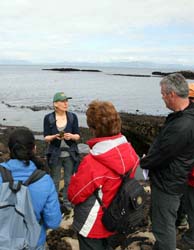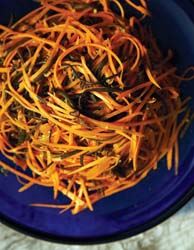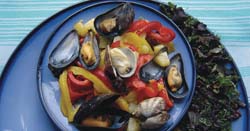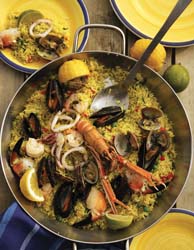Sea Harvest - Food For Free
 With the nation’s foodie mindset already well tuned in to sustainable living – thousands of us started allotments this year, and no allotment is complete without its bijou chicken run – the next stage is to re-learn all the practical skills that our grandparents took for granted.
With the nation’s foodie mindset already well tuned in to sustainable living – thousands of us started allotments this year, and no allotment is complete without its bijou chicken run – the next stage is to re-learn all the practical skills that our grandparents took for granted.
Darina Allen’s fantastic book Forgotten Skills of Cooking (Kyle Cathie, rrp €31.50) covers brilliantly all the jobs that would traditionally be done on a smallholding and in the domestic kitchen (with hundreds of recipes to match), and this mega-tome also includes a chapter on foraging which makes very interesting reading – although it’s a bit on the heavy side to bring with you!
If you’re having holidays anywhere on the coast, it could be even more fun if you set off on a mission to find out more about what edible plants grow near and in the sea – and how much free food you can put on your holiday table!
There are loads of books on ‘gastro-foraging’ these days, but the daddy of them all is Richard Mabey’s 1972 classic Food For Free which still available – and it’s currently on amazon.co.uk, from as little as £2.50 for a cute little book to fit a backpack. Mabey covers everything, including coastal plants and those that live ‘on the edge’ just above the tideline, like sea spinach and the keenly-sought samphire.
And then there is that other world – mysterious to many of us, but as familiar as the back garden to families living along the coast or on islands, who have grown up with the rhythm of the tides and the briney harvest that is revealed every twelve hours.
People like Sligo GP, Prannie Rhatigan, whose beautiful book Irish Seaweed Kitchen (€35) is the first comprehensive guide to harvesting, preparing and cooking Irish seaweeds, which she describes as “..a living treasure by the shore, more valuable by far than any golden coins that may lie buried beside it in the sand.”
And her book is a magnificent celebration of the beauty and riches of the Irish shoreline, with stunning photography, all the practical information you could want, lots of recipes and a light touch – there’s a sense of friends and family milling around, echoing the swirling seaweeds in the tide.
Ralph Waldo Emerson's definition of a weed as ‘a plant whose virtues have not yet been discovered’ is particularly true of seaweeds...
There are fifteen varieties of red, brown and green seaweed featured in The Irish Seaweed Kitchen, all detailed in a Glossary giving the (considerable) health benefits as well as culinary uses. And there is nothing ‘weird’ about any of them, as you’ll find out very quickly once they all become as familiar as carrageen already is to many cooks.
They can be used whole as a vegetable, or ground/flaked to use as a herb in cooking, or to sprinkle over food as a salt and/or pepper replacement. Dried or rehydrated seaweeds can also be eaten as a snack - duileasc was a favourite generations ago in Ireland, as nori/sleabhac is today in Japan – or as a recipe component.
Getting Going
To make the most of cooking with seaweed, Prannie recommends that a little planning will help people who have not previously used it in the kitchen.
• Start with easy to use seaweeds in simple recipes. Have a look at the seaweeds in the glossary/chart in the book, and perhaps add the following to your kitchen press:
• A pack of Alaria, a pack or jar of seaweed stock, ground nori, sheet nori, some sea spaghetti and kelp.
And if you can’t get down to the sea at the moment, Irish seaweed suppliers produce some really flavoursome mixes, worth checking out in your local health food store or deli. Prannie also includes a full list of Irish seaweed suppliers in the book, and web addresses for buying online.
 Carrot and Sea Spaghetti Salad
Carrot and Sea Spaghetti Salad
Willowy sea spaghetti and delicate carrot strips combine with a sweet garlicky dressing to create this colourful salad. Easy to prepare, Prannie makes this salad regularly for demonstrations - it never fails to delight even first time seaweed tasters.
Seaweed used: sea spaghetti (very easy to recognise, the name says it all!)
Serves 4-6
Click for recipe
 Potato Stir fry with Seaveg and Seafood
Potato Stir fry with Seaveg and Seafood
The ultimate no fuss dinner - once the potatoes have been cooked (and sliced cooked day old potatoes also work well), the remainder of this delicious meal is quickly prepared in one pot. Can also be made vegetarian, without the seafood.
This recipe is from Manus McGonigle of Quality Sea Vegetables, Co Donegal, a seaweed harvester who enjoys the mix of seafood and seaweed readily available to him on the north west coast.
Seaweed Used: mixed Sea Vegetables
Serves 2
Click for recipe
 Seafood Paella
Seafood Paella
Alaria and sea spaghetti add the final layer of seafood flavour to this seafood dish, contributed by Donegal medics Paul and Bella Stewart.
Great for a special occasion and even more idyllic if you can cook it outdoors...
Seaweed Used: Alaria (the familiar wavy brown fronds, very widely available and used extensively in Irish Seaweed Kitchen) and sea spaghetti
Serves 4
Click for recipe





There are currently no comments
Leave a comment
Not a member? Register for your free membership now!
Or leave a comment by logging in with: